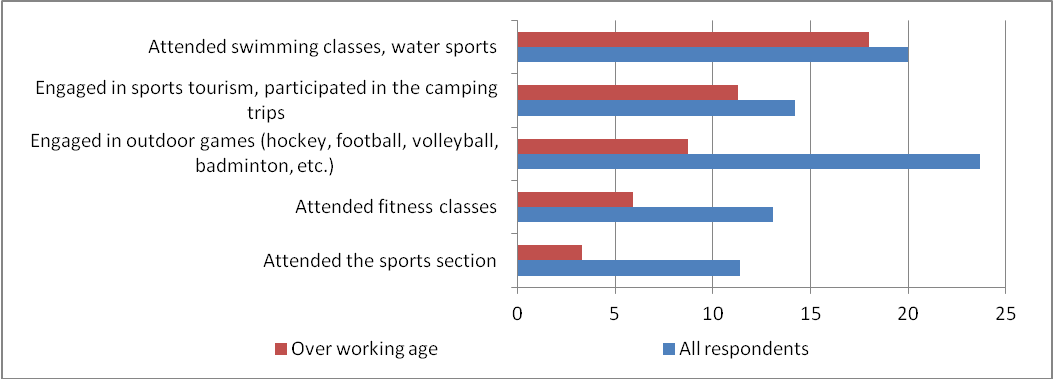Marketing of health and fitness services for senior consumers: new opportunities and challenges
Фотографии:
ˑ:
PhD J.V. Astashova1
Dr.Sc.Econ. I.Y. Okolnishnikova1
PhD A.I. Ukhova1
PhD A.I. Demchenko1
1South Ural State University, Chelyabinsk
Keywords: health and fitness services, senior consumers, gerontomarketing, population ageing, market.
Introduction. Due to population aging, the structure of consumers in the market is also changing significantly. In contrast to the general population reduction, the older consumers involvement is a strategic task for business in most commodity markets. The trend of business targeting for older consumers is not yet evident in all markets. Nevertheless, it is possible to single out a number of the most promising markets, where gerontomarketing, as the marketing concept oriented to older consumers, has the greatest premises for development, including the sports and health services market. Thus, the objective of the study was to analyze the development of sports and health services market for older customers and explore the marketing opportunities and constraints.
Methods and structure of the study. The theoretical and methodological basis of the study was the domestic and foreign research works in the field of gerontomarketing [3]. The research applied the methods of statistical data analysis, and nonformalized desk methods of marketing research.
Results and Discussion. An urgent task now is to extend social and economic activity of the elderly population in order to reduce the effects of the increasing demographic burden.
The urgent task of the present time is to prolong the social and economic activity of the elderly people in order to reduce the growing demographic burden.
The study identified the following indicators of aging and its consequences:
- physiological factors (health deterioration)
- socio-psychological factors (change in the usual circle of contacts, loss of a partner, increase of free time due to retirement);
- economic factors (reduction in income).
The appearance of the aging indicators is not age related, but individual and depends more on the discontinuation of employment. Thus, we can conclude that health is critical, as evidenced by a number of studies investigating the impact of retirement and deterioration in health, both physical and psychological [1, 2, 4]. In general we can say that the decline in health is not only a major cause of retirement, but may be one of the consequences of the discontinuation of employment.
Official statistics show that in 2015 more than 40% of Russian citizens receiving old-age pension, continue their career, which shows the relevance of health-behaviour strategies among elderly people. In this regard, the sports and health services market is one of the promising areas for the gerontomarketing practice development.
Sports activities are a universal tool for prolonging the physically active period of human life, and as a result the economic activity of elderly people. Also, sports as a hobby solve the issues of organized leisure time for pensioners, clubs and sport sections attendance leads to formation of their new circle of contacts.
According to statistics only 35% of senior citizens are engaged in active sports (versus 50% in the general group of respondents). Data on the popularity of sports activities among the elderly people are presented in Fig. 1.

Figure 1. The popularity of sports activities by age groups
As shown in Fig. 1, fitness and sport sections are less popular kinds of sports services, whereas these very services are provided in the format of sport clubs and are the most accessible in cities from the point of view of infrastructure.
The marketing research of the Russian sports and health services market for elderly consumers allows us to conclude that this segment has just started forming and its development rates do not match the pace of population aging. On average, approximately 25,000 of elderly people account for one sports and fitness organization in Russia's 15 largest cities, which offers a specialized program for older consumers. During the analysis of the assortment policy, the most prevalent in the Russian market types of sport and health services for elderly consumers were identified (Fig. 2).
Introduction of specialized programs for older consumers to the assortment creates new market opportunities for sports and fitness organizations, and also helps solving the following marketing tasks:
- decrease in intraday and intra-week seasonality;
- customer retention;
- socially responsible business image formation.

Figure 2. The most represented types of sports and health services for older consumers in the Russian market
In the study, we also highlighted the factors hindering the sports and health service market development:
- older consumers solvency (to a greater extent this applies to pensioners);
- cultural traditions that define the elderly person's behaviour and common stereotypes in the perception of the elderly people by community.
To overcome the mentioned factors is not only the goal of market participants, implementing a competent marketing policy, but also an essence of the government policy in the situation of aging population. Public opinion on the active aging model should be formed with the use of social PR (Public Relations) tools, which should be aimed at overcoming the negative perception of the pensioner's image, also among elderly people.
Conclusions. Thus, we can conclude that the development of the sports and health services market for older consumers is aimed at meeting not only the need for health maintaining, but also for organizing leisure for the elderly people. At the same time, the elderly segment involvement in sports clubs creates new marketing opportunities for the market participants. In addition, it is necessary to overcome the factors constraining the market development to reduce the consequences of the demographic population aging and should be referred to the government policy tasks in the field of social support for the elderly people.
References
- Andriyanov S.V., Roganina M.V. Fizicheskaya aktivnost pozhilykh lyudey kak bazovaya determinanta aktivnogo obraza zhizni [Physical activity of elderly people as a basic determinant of active lifestyle]. Byulleten meditsinskikh internet-konferentsiy [Bulletin of Medical Internet conferences], 2015, vol. 5, no. 5, p. 737.
- Arstangalieva Z.Zh., Chernyshkova E.V., Andriyanova E.A. Praktiki zdoroviesberezheniya sovremennykh rabotayushchikh pensionerov [Practice of health promotion of modern working pensioners]. Sovremennye issledovaniya sotsialnykh problem, 2015, no. 7 (51), pp. 41–51.
- Bagiev G.L., Bogdanov E.G., Boytsova A.E. Sotsialno-ekonomicheskie faktory formirovaniya i razvitiya gerontomarketinga [Gerontomarketing: socio-economic factors of formation and development]. Problemy sovremennoy ekonomiki [Problems of modern economy], 2012, no. 2, pp. 207–211.
- Maltseva E. Slaboe zdorove meshaet pensioneram rabotat [Weak health interferes pensioners with work]. 2012. Available at: http://www.opec.ru/1722324.html
Corresponding author: julia_asta@mail.ru
Abstract
Physical activity of elderly people in an ageing society is a condition for their social and economic activity, which helps reduce the negative consequences of the population ageing. Physical education helps maintain health and it is a form of leisure for a pensioner. However, the Russian sports and health services market for senior consumers is still underdeveloped. The marketing study results allow to conclude that the development rate of the domestic sports and health services market for senior consumers does not correspond to the Russian population ageing rate. The study also established the factors constraining the market development: the solvency of the consumer, as well as negative stereotypes about elderly people. During the analysis of Russian sports and health services market companies for senior consumers marketing opportunities were found, as well as tasks to be solved within the government policy in the population ageing conditions.



